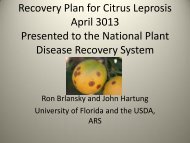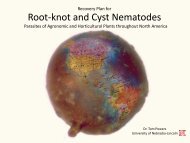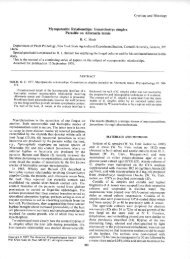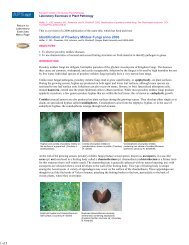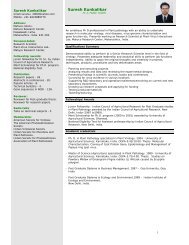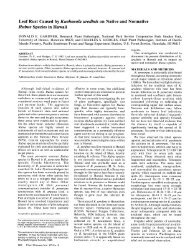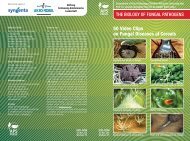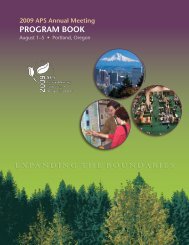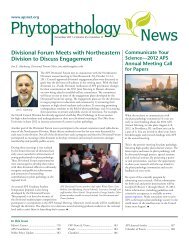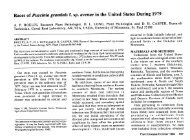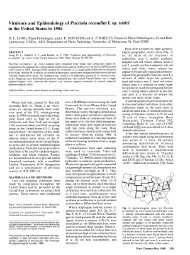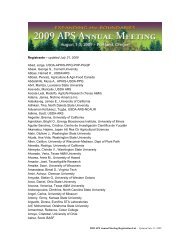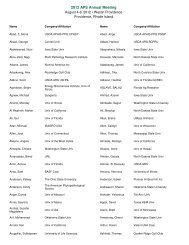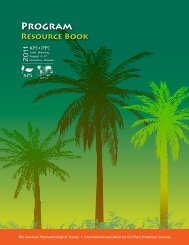view article - American Phytopathological Society
view article - American Phytopathological Society
view article - American Phytopathological Society
You also want an ePaper? Increase the reach of your titles
YUMPU automatically turns print PDFs into web optimized ePapers that Google loves.
86 when root numbers were lowest. This indicates that citrus<br />
roots may be able to compensate for root damage or reduced<br />
THE `FECT OF CXMPOSTED MUNICIPAL SEWAGE SLUDGE (CIVISS) ON numbers with increased efficiency of root uptake.<br />
PHYTOPHTHORA ROOT ROT AND SCLEROTINIA CROWN AND STEM ROT OF<br />
ALFALFA. R. P. Woodward and R. B. Carroll, Department of Plant<br />
Science, University of Delaware, Newark, DE 19717-1303. 90<br />
Saranac alfalfa was planted into 15.2 cm pots containing autoclaved<br />
silt loam soil amended with C(SS obtained from three<br />
municipalities. Experimental design was a randomized complete<br />
block with five replications. Treatments were loading rates of<br />
11.2, 22.4, 44.8, 112.0, and 224.0 Mg/ha of each CMSS.<br />
Phytophthora megasperma f. sp. medicaginis (Pmm) and<br />
Sclerotinia trifoliorum via ixig (St) ito inocula oil achamed rio were toplatin. applied separately Aterresistance<br />
via mixing into each amended soil prior to planting. After<br />
nine weeks, disease development was rated. No significant<br />
differences (P=0.05) were noted with respect to 41455 origin,<br />
Significant Pmm disease suppression occurred at 44.8 and<br />
112.0 Mg/ha. Suppression of disease caused by St occurred at<br />
all loading rates. Isolations from infected root and crown<br />
tissues indicated less Pmm was recovered as the CMSS rates<br />
increased but St remained constant.<br />
87<br />
SOILS SUPPRESSIVE TO BLACK ROOT ROT OF BURLEY TOBACCO IN<br />
WESTERN NORTH Carolina. Julie R. Meyer and H. D. Shew. Dept.<br />
of Plant Pathology, North Carolina State University, Raleigh,<br />
NC 27695-7616.<br />
SoiLs suppressive to black root rot were identified by th<br />
abs supprese in blac rotrter identified bythe<br />
absence of disease to black in root fields rot planted and containing in cultivars 2-500 with cfu/g low soil of<br />
Thielaviopsis basicola. Suppressiveness was confirmed under<br />
controlled environmental conditions with several pathogen<br />
isolates and host cultivars.<br />
ies<br />
Suppressiveness<br />
and sultivaro. Suppressive e<br />
was<br />
s<br />
not<br />
of T.<br />
the<br />
result of reduced survival of the chlamydospores of T.<br />
basicola. The suppressive factor appears to be abiotic and<br />
associated with soil acidity. Soil amendments were used to<br />
separate the effects of different components of acidity (soil<br />
pH, base saturation, exchangeable Al) on disease. The results<br />
suggest that soil Al may be the mechanism of suppressiveness in<br />
these soils.<br />
EFFECT OF INSECT DEFOLIATION ON SEVERITY OF FUSARIUM CROWN-<br />
ROT OF ALFALFA. P. D. Colyer,I J. W. Lee, 2 and S. S.<br />
Quisenberry. 91<br />
2 Louisiana State University Agricultural Center,<br />
Louisiana Agricultural Experiment Station, Red River Research<br />
Station,I Bossier City, LA 71113 and Department of Entomology,<br />
COLONIZATION OF SOLANUM TUBEROSUM L. BY COLLETOTRICHUM COC<br />
2<br />
Baton Rouge, LA 70803.<br />
(WALLR.) HUGHES A.W. Barkdoll and J.R. Davis, Univ. of Idaho<br />
R&E Center, Aberdeen, ID 83210<br />
Alfalfa, Medicago sativa L. variety 'Florida 77', was inoculated<br />
with three different isolates of Fusarium and defoliated<br />
to varying levels with yellowstriped armyworms, Spodoptera<br />
ornithogalli (Guenee), to determine the effect of insect<br />
defoliation on the development of crown-rot under greenhouse<br />
conditions. There were no significant interactions between<br />
short-term insect defoliation and Fusarium crown-rot on forage<br />
quality, yield, or root carbohydrate reserves. Although<br />
insect defoliation alone did reduce plant height, yield,<br />
and maturity (18,33, and 30%, respectively) at the first<br />
harvest, no significant effects were observed at two subsequent<br />
harvests. Fusarium oxysporum Schlecht was the most virulent<br />
of the three isolates tested.<br />
Colletotrichum coccodes can be found in roots, tubers, stem<br />
bases and apices of potato in the field. Tubers from foliar<br />
inoculated potatoes contained significant differences (P=O.Ol)<br />
in colony forming units (cfu's) of C. coccodes of 2000 and 300<br />
in stem and bud ends respectively. Surface disinfestation of<br />
tubers with 10% clorox did not reduce cfu's. In <strong>view</strong> of the<br />
high cfu's of C. coccodes in tubers and stems an experiment was<br />
conducted to evaluate fungal colonization of potato originating<br />
from infested seed tubers. Russet Burbank mini-tubers wgre<br />
inoculated with a conidial suspension (50 ul of 9.2 x 10<br />
conidia/ml) of C. coccodes and were planted in the greenhouse.<br />
The resulting pl-ants were destructively sampled three times<br />
during the season. Stem apices and bases, roots and soil were<br />
sampled for C. coccodes at each period. At no sampling period<br />
88<br />
was C. coccodes detected in stem bases or apices. In contrast,<br />
C. coccodes in soil increased from zero to above 0.2 cfu/g soil.<br />
Root infection at the last sampling increased from 0 to 15%.<br />
CORRELATION BETWEEN SAMPLES FOR ESTIMATION OF INOCULUM DENSITY<br />
OF CYLINDROCLADIUM CROTALARIAE IN SOIL. A. K. Culbreath, r1.<br />
K. Beute, and B. B. Shew, Depts. of Plant Pathology, Coastal 92<br />
Plain Univ., Expt. Raleigh, Stn., NC Tifton, 27695. GA 31793 and North Carolina St.<br />
COLONIZATION AND PATHOGENICITY OF FUSARIUM OXYSPORUM AND F.<br />
Four quadrants, each consisting of 63 (13.7 mi<br />
SOLANI ON ESSEX SOYBEAN. G. M. Farias and G. J. Griffin.<br />
2 ) contiguous<br />
plots were established in a field naturally infested with<br />
Cylindrocladium crotalariae in Martin County, NC, in 1988.<br />
Half adjacent of the area field was was planted planted to peanuts. to corn the Two previous quadrants year and an<br />
(designated peanut or corn) were situated in each area. Two<br />
independen samplest e corn)weresisuting<br />
of 12 acm diam. To<br />
independent samples, each consisting of 12 (2.5 cm diam. x<br />
16.5 cm) soil<br />
density<br />
cores, were taken from all plots. Inoculum<br />
elutriation-selective<br />
(ID) of C. crotalariae<br />
medium technique.<br />
was estimated<br />
Both<br />
using<br />
samples<br />
an<br />
gave<br />
similar estimates of mean ID in each quadrant; ID was<br />
in<br />
greatest<br />
peanut quadrants. Estimates of ID from the two samples<br />
were highly correlated (p < 0.01) in peanut quadrants but were<br />
not significantly correlated in corn quadrants,<br />
Department of Plant Pathology, Physiology and Weed Science.<br />
Virginia Polytechnic Institute and State University. BlaCksburg,<br />
VA 24061.<br />
Colonization Clnzto of fEsxsyenctldn Essex soybean cotyledons by yFsru Fusarium oxysp xsou<br />
occurred 1 day after planting in naturally infested soil and the<br />
fungus was present at high frequency (25%) after 4 days. F.<br />
oxysporum and F. solani colonized the lower hypocotyl and -<br />
emerging 4 days both roots fungi 2 and were 3 days found after colonizing planting, t elongatin respectively. Afer<br />
portion of the hypocotyl. The hypocotyl-root transition 9 , upper zone had<br />
the highest frequency (20-28% of 2-mm tissue segments)<br />
nization<br />
of colo-<br />
by each species at 4 days. F. solani had higher<br />
colonization rates per unit of inoculum than F. oxysporum (0.042<br />
and 0.023 colonizations/m root/propagule/g soil after 4 days,<br />
89<br />
respectively). In soil-temperature tank tests at 20 C and -0.01<br />
MPa water potential, all of the four<br />
solani<br />
F. oxysporum<br />
isolates<br />
and four<br />
tested<br />
F.<br />
delayed seedlilig emergence and caused<br />
significant reductions in stem length and plant fresh weight.<br />
ROOT UPTAKE OF RUBIDIUM-86 BY CITRUS ROOTS AS AFFECTED BY ROOT<br />
PATHOGENS, SEASON AND IRRIGATION. Q. A. Menge, E. L. V.<br />
Johnson, E. Pond and H. Liu. Dept. of Plant Pathology, 93<br />
University of California, Riverside, CA 92521.<br />
THE EFFECT OF PLANTING DATE ON FUSARIUM WILT OF M4USKMELON IN<br />
Uptake of Rb" by 1-cm pieces of excised citrus root tips was CALIFORNIA. 0. J. Jacobson and I. R. Gordon, Dept. of Plant Pathmeasured.<br />
In a greenhouse experiment, roots from Troyer ology, University of California, Berkeley 94720.<br />
citrange inoculated with Phytophthora parasitica absorbed 36%<br />
less Rb" than roots not inoculated with P. parasitica. In the A randomized complete block design was employed with planting<br />
field, trees treated with nematicides and fungicides (oxamyl dates as blocks and susceptible and resistant cultivars as<br />
and metalaxyl) consistently exhibited a 27-57% greater uptake treatments; the experiment was conducted for two years. Cortical<br />
of Rb" than did non-treated trees. Most of this increase in root colonization by Fusarium oxysporum f. sp. melonis was<br />
uptake was observed July-October when P. parasitica and nematode measured on seedlings and at full fruit load. Rate of disease<br />
populations were high. Uptake of Rb" was greater in roots of progress and incidence at harvest were both higher during hotter<br />
citrus receiving irrigation which was 80% and 120% of the portions of the growing season. Root colonization by the<br />
evapotranspiration demand (ETD) than by those receiving 100% of pathogen was not affected by planting date; cultivar differences<br />
the ETD. Root uptake of Rb" fluctuated considerably on a were apparent only at full fruit load and may represent xylem<br />
seasonal basis and was greatest during the summer months and colonization of the susceptible host. Inoculumn varied sig-<br />
1146 PHYTOPATHOLOGY



